If you have a pool in your backyard, you know that keeping the surrounding concrete area safe and slip-free is important. However, if your concrete has become slippery over time, don’t worry – there are ways to fix it! This blog post will outline how to fix slippery concrete around pool. Keep reading to learn more.
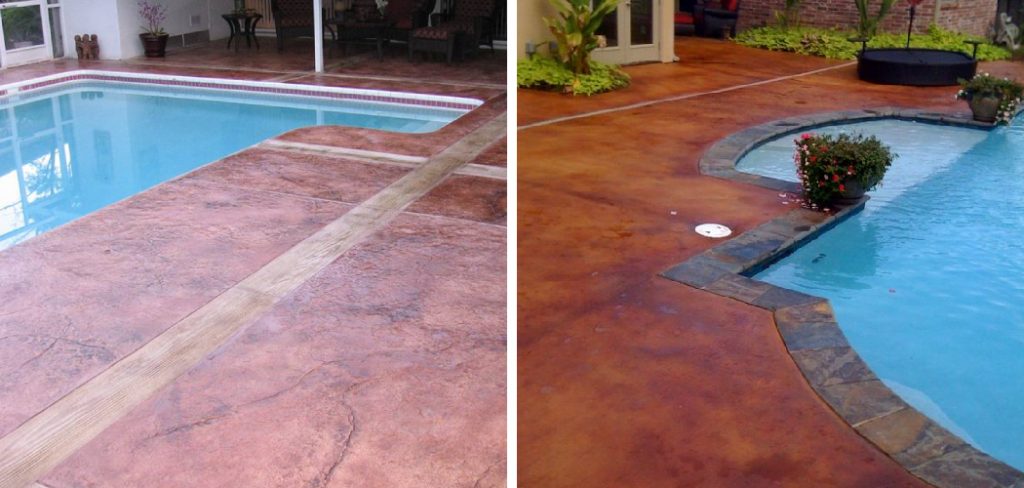
Summary: Slipping on wet concrete around a pool can be dangerous, so it’s important to properly fix the issue. For non-slip coating, first make sure the concrete surface is clean and dry. Then apply the coating according to instructions and let it dry for a few days before using the pool.
For an anti-slip tread system, measure where you want to place the stamps and pre-drill the holes. If needed, add a primer coat and then line up the stamps in rows along stairways or any other areas that have a lot of traffic. Fill any gaps with grout and allow it to dry overnight before walking on it or putting in pool furniture.
What Causes Slippery Concrete Around Pools?
A few different things can cause concrete to become slippery around pools. One of the most common causes is algae growth. Algae can grow on concrete surfaces that are constantly wet, like those around pools. The slimy texture of algae can make concrete slippery and dangerous. Another common cause of slippery concrete around pools is calcium deposits. Calcium deposits can form on concrete that is regularly exposed to the pool water. Over time, these deposits can build up and make the surface of the concrete slippery.
Additionally, weather can also play a role in making concrete slippery. For example, if the temperature outside is cold, concrete can become icy and dangerous. The other weather-related issue that can contribute to slippery concrete is rain. If the concrete around your pool gets wet from rain, it can become slippery. Lastly, if your concrete is old, it may become more brittle and slippery over time.
Why Is It Important to Fix Slippery Concrete Around Pools?
It is important to fix slippery concrete around pools for a few reasons. First and foremost, it is a safety issue. If the concrete around your pool is slippery, someone could easily slip and fall, leading to serious injury. Secondly, fixing slippery concrete can help to prolong the life of your pool. If concrete is left slippery, it will eventually deteriorate and need to be replaced. You can avoid having to replace it down the road by taking the time to fix it now.
Another reason to fix slippery concrete is that it can be unsightly. If you have algae or calcium deposits on your concrete, it can take away from the overall look of your pool area. Additionally, if your concrete is old and beginning to crumble, it can make your pool area look run-down. Therefore, it is important to keep up with the maintenance of your pool area to ensure that it looks its best.
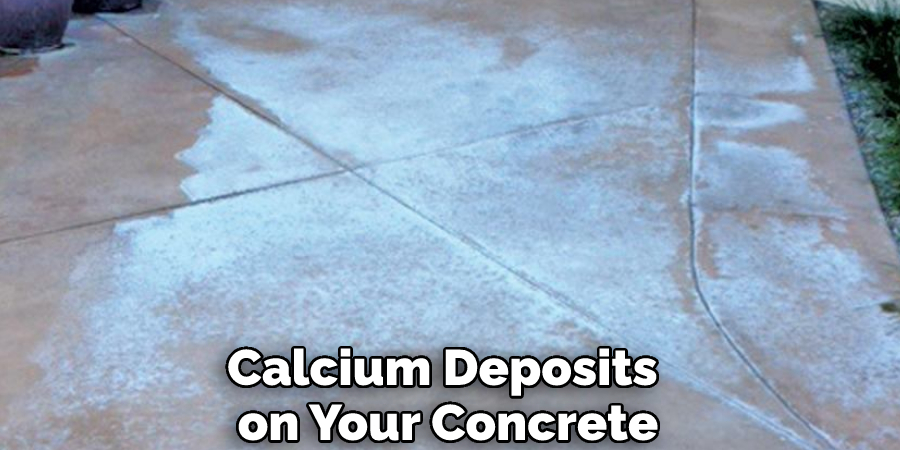
Finally, fixing slippery concrete around pools can help to increase your home’s value. If you ever decide to sell your home, potential buyers will see that you have taken good care of your pool area and that it is safe. This can help increase your home’s value and make it more attractive to buyers.
Some Effective Ways How to Fix Slippery Concrete Around Pool
1. Pressure Wash the Concrete
Pressure washing the concrete around your pool is a great way to remove any algae or calcium deposits that might make it slippery. You can rent a pressure washer from your local hardware store or home improvement center. To pressure wash the concrete, set the machine to a low setting and hold the wand about six inches from the surface of the concrete. Then, move the wand back and forth across the surface of the concrete until it is clean.
2. Use a Concrete Cleaner
If pressure washing doesn’t seem to be doing the trick, you can try using a concrete cleaner. You can find concrete cleaners at your local hardware store or home improvement center. Be sure to read the instructions on the cleaner before using it. Some cleaners need to be diluted with water, while others can be used at full strength. To use the cleaner, first wet the concrete with a hose.
Then, apply the cleaner to the surface of the concrete and scrub it with a brush. Finally, rinse the cleaner off with a hose and let the concrete dry. If the cleaner isn’t working, you can try using a stronger one or even a power washer.
3. Apply a Concrete Sealer
Applying a concrete sealer is another great way to make the surface of your concrete less slippery. This is because sealers create a smooth, hard surface that is less likely to be slippery than unsealed concrete. Not only will this help to make your pool deck safer, but it will also make it look more polished and high-end. There are two different types of concrete sealers that you can choose from: water-based and solvent-based.
Water-based sealers are typically less toxic and easier to apply, but they don’t last as long as solvent-based sealers. Solvent-based sealers, on the other hand, are more durable but can be more difficult to apply and can emit strong fumes. To apply a concrete sealer, start by cleaning the surface of your concrete with a power washer or a hose and a scrub brush.
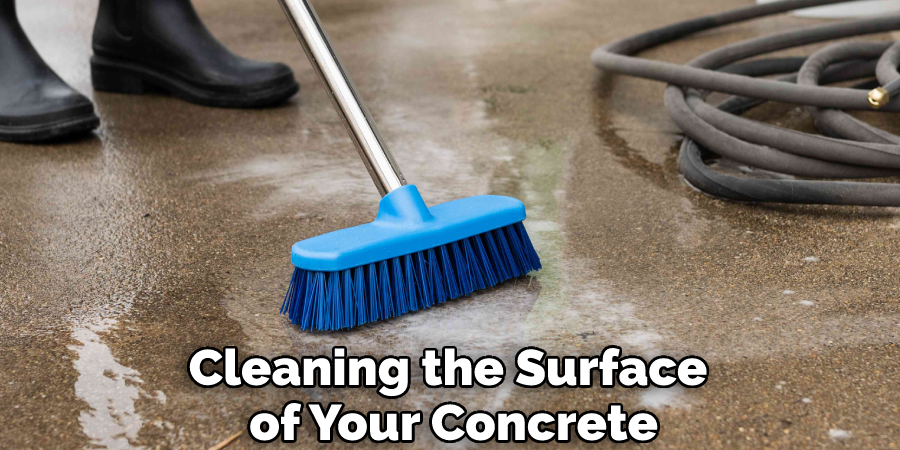
Once the surface is clean, apply the sealer with a roller or a brush, and carefully coat the entire surface evenly. You’ll likely need to apply two coats of sealer, so be sure to let the first coat dry completely before applying the second.
4. Use Pool Deck Paint
If you want to add a little bit of color to your pool deck, you can try using pool deck paint. This is a special type of paint that is designed to be slip-resistant. It can also come in various colors, so you can choose the one that best suits your taste. First, clean the concrete surface thoroughly and then apply the paint according to the manufacturer’s instructions. If you want, you can also add a non-slip additive to the paint to further increase its slip resistance.
5. Add Non-slip Additives to the concrete
If you want to make your concrete less slippery without changing its appearance, you can try adding a non-slip additive to the concrete when you mix it. There are a few different types of non-slip additives that you can use, so be sure to check with your local home improvement store to see which one would be best for your needs. First, you’ll need to mix the additive into the concrete according to the package directions.
Once the additive is mixed in, you can proceed with pouring and finishing the concrete as usual. You may need to experiment with a few different types before you find one that works well for you.
6. Place Non-slip Mats
If you don’t want to change the appearance of your concrete, you can try placing non-slip mats on the surface to create traction. This is a good option for those who want an inexpensive and quick fix. However, mats can move around and may need to be replaced frequently. Place mats around the pool, on any steps, and in areas where people are likely to walk. Avoid using mats on wet concrete, as this can cause the mat to slip.
7. Install Textured Tiles
Textured tiles are another great way to make your concrete less slippery. They can be placed on the surface of the concrete to create traction and prevent slipping. Many different types of textured tiles are available so that you can choose the perfect one for your needs. To install them, clean the concrete surface and apply a tile adhesive. Once the adhesive is dry, you can place the tiles on top. Be sure to press them firmly into place so that they adhere properly. Allow the tile adhesive to dry completely before walking on the surface.
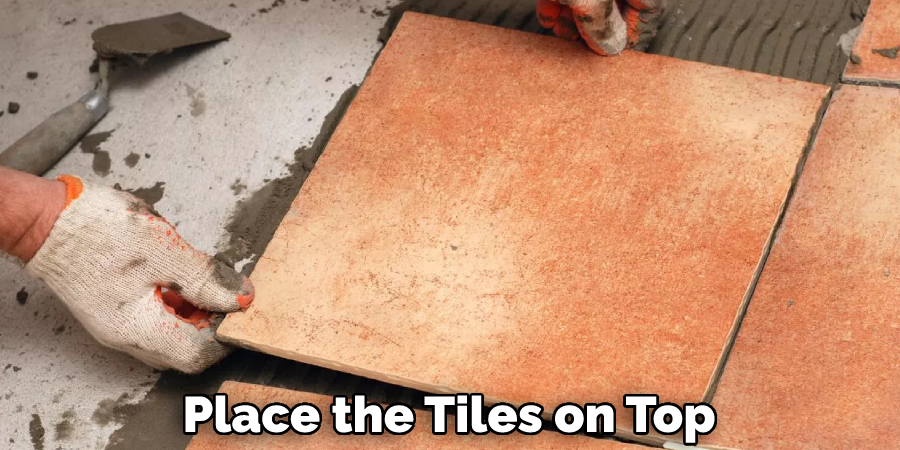
Tips and Warnings on How to Fix Slippery Concrete Around Pool
Tips:
- Be sure to hose off and clean the affected area before beginning repairs.
- Use a putty knife or another similar tool to apply the epoxy.
- Work in small sections to avoid making a mess.
- Be sure to smooth out the epoxy once applied.
- Allow the epoxy to dry completely before walking to the repaired area.
Warnings:
- Be sure to wear gloves when working with epoxy.
- Do not apply epoxy in direct sunlight or heat, as this can cause it not to set properly.
- If you are unsure about how to mix or apply epoxy, be sure to consult with a professional.
- Do not apply epoxy to an area that is wet or damp.
- Be sure to read all instructions on the epoxy before beginning repairs.
How Much Does It Cost How to Fix Slippery Concrete Around Pool?
The cost of repairing slippery concrete around your pool will depend on the severity of the problem and the chosen method of repair. For small areas, you may be able to get by with a do-it-yourself kit that costs around $50. However, for larger areas or more severe problems, you may need to hire a professional to do the job, which can cost anywhere from $500 to $1,000.
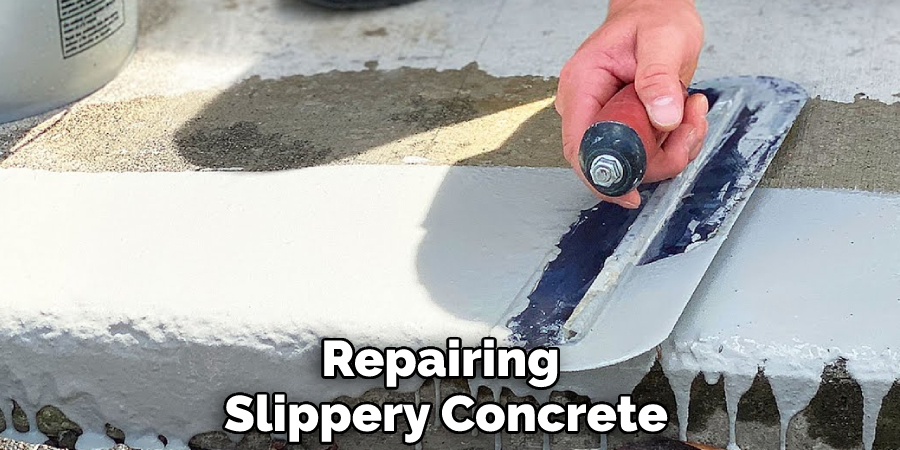
Frequently Asked Questions
Should You Seal Concrete Around Pool?
the best decision may depend on the type of concrete and pool that you have. However, sealing concrete around a pool can help to protect it from weathering and deterioration, reduce noise levels caused by splashing/fountains, and keep insects away.
Sealing concrete around a pool typically requires two steps: first, an adhesive is applied to the surface of the concrete; second (and more importantly), rebar or metal rods are inserted into the adhesive and into any cracks in the substrate. Once all surfaces are secured together, pressure is steadily applied until it reaches a predetermined level (normally 10 PSI). This prevents moisture vaporization (the process by which water molecules escape) and allows for long-term protection against harsh elements.
Why is My Concrete Slippery?
There are a few reasons why concrete may be slippery. One common cause is water damage, which causes the surface of the concrete to become wet and slippery. Acid rain or other environmental conditions can also contribute to poor cement quality, which results in slipping and sliding.
Does Concrete Sealer Make It Slippery?
There is no definitive answer to this question as it depends on a variety of factors, including the type of concrete sealer that is being used. Some sealers may make the surface more slippery, while others may not have any effect at all. In general, if you are concerned about making the surface slippery, it is best to test the sealer on a small area first to make sure there is no negative impact.
Is Stamped Concrete Too Slippery Around a Pool?
Stamped concrete can be a beautiful addition to your backyard pool area, but you need to be careful not to make it too slippery. This ultra-slippery material is great for sidewalk applications, but it’s not the best choice for pools because of its extreme traction.
If you do choose stamped concrete for your pool area, keep in mind that pool edges should be smooth and free from seams or bumps so that children and pets don’t get stuck. If there are any problems with the installation or during use, always call a professional installer!
Conclusion
So there you have it! Everything you need to know about how to fix slippery concrete around pool. Be sure to follow the tips and warnings listed above to avoid any accidents or injuries. With a little bit of time and effort, you’ll have your concrete repaired in no time. Thanks for reading!
